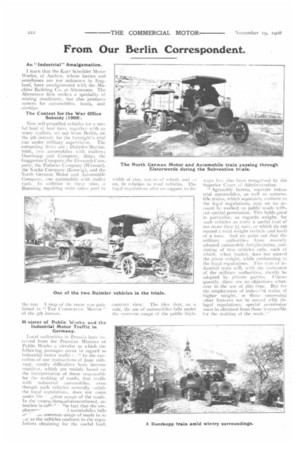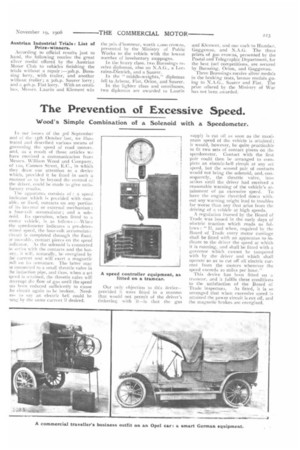From Our Berlin Correspondent.
Page 16

Page 17

If you've noticed an error in this article please click here to report it so we can fix it.
An "Industrial" Amalgamation.
1 learn that the Kurt Scheibler Motor Works, of Aachen, whose lorries and omnibuses are not unknown in England, have amalgamated with the Machine Building Co. at Altenessen. The Altenessen firm makes a speciality of mining machinery, hut also produces motors for automobiles, boats, and airships.
The Contest for the War Office Subsidy (19091.
Nine self-propelled vehicles fur a useful load of four tons, together with as many trailers, set out from Berlin, on the 9th instant, for the fortnight's trial run under military supervision. The competing firms are ; Daintler-Marienfelde, two automobiles with trailers; Duerkopp and Company, ditto; the Gagg-enau Company,the Eisenach Company, the Podaens Company (Wismar), the Nacke Company (Koswig), and the North German Motor and Automobile Compan, one automobile with trailer each. In addition to these nine, a 13uessing repairing train takes part in the run. A map of the route was published in " Tint CommtIRctlt. Moron " of the 5th instant.
M.'nister Of Public Works and the Industrial Motor Traffic in Germany.
Local authorities in Prussia have received from the Prussian Minister of Public Works a circular in which the following passages occur in regard to industrial motor traffic in the execution of our instructions of June toth, 1907, sundry difficulties have become manifest, which are mainly based on the interpretation of those resisaisible for the making of roads, that traffic with industrial automobiles, even though such vehicles severally tttisfy the legal regulations, does not come under the usage of the roads. In the mstruLtionsaforementioned, attention is calk' ate fact that the em ployer c"' _1 automobiles falls at: common usage of roads in so as the vehicles conform to the regulations obtaining for the useful load,
width of rim, nat;:re of wheel, and on, in relation to road vehicles. The legal regulations offer no support to the
contrary view. The idea that, as a rule, the use of automobiles falls under the common usage or the public high
ways has also been recognised by the superior Court of Administration.
" Agreeably hereto, separate industrial automobiles, as well as automobile trains, which separately conform to the legal regulations, may on no account he worked on public roads without special permission. This holds goo(I in particular, as regards weight, for such vehicles as carry a useful load of not more than 71tons, or which do not exceed a total weight (vehicle and load) of q tons. And we point out that the military authorities have recently adopted automobile freight-trains, consisting of two vehicles only, each of which, when loaded, does not exceed the given weight, while conforming to the legal regulations. This type of industrial train will, with the assistance of the military authorities, shortiv be adopted by private parties. Consequently, there are no objections whatever to the use of this type. But for the employment of industrial trains of higher weight, or those nossessing other features not in arc< rd with the legal regulations, special permission must he obtained from those responsible for the making of the roads.—
Austrian Industrial Trials : List of Prize-winners.
Accordingto official results just to hand, the following receive the great silver tnexial offered by the Austrian Motor Club to vehicles finishing the trials without a repair :-3oh.p. Suessing lorry, with trailer, and another without trailer; a 3oh.p. Saurer lorry; and a 4oh.p. Fiat lorry. With an omnibus, Messrs. Laurin and Klement win
the prix d'honneur, worth t,000 crowns, presented by the Ministry of Public Works to the vehicle with the lowest number of involuntary stoppages.
In the heavy class, two Buessings receive diplomas, also an N.A.G., a Lorraine-Dietrich, and a Saurer.
In the " middle-weights," diplomas fell to Arbenz, Fiat, Orion, and Sauter.
In the lighter class and omnibuses, two diplomas are awarded to Laurin and Klement, and one each to Humber, Gaggenau, and N.A.G. The three prizes of soo crowns, presented by the Postal and Telegraphic Department, for the best fuel competitions, are secured by Buessing, Orion, and Gaggenau.
Three Buessings receive silver medals in the braking tests, bronze medals going to N.A.G., Saurer and Fiat. The prize offered by the Ministry of War has not been awarded.




















